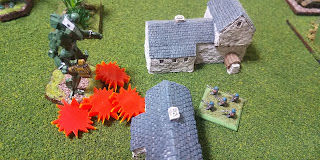The defence of Saint Augustin
I found myself with a few hours to spare and thought that it would be nice to pit the forces of Volgar against the five Duchies. Time was limited; though, so I thought that rather than use my usual mash up of the War game, which takes time to prepare, I would turn to another favourite of mine, One-hour Wargames by Neil Thomas.
One-hour Wargames are a very simple, but excellent set of rules that really do play in an hour or under. Within the pages of the book, you have a set of general rules that are then tweaked to give some period feel. Are they for everyone? Probably, not, but they allow me to have a fun game on a 2` by 1.5` table in a very reasonable amount of time. As well as the rules the book has thirty scenarios in it, so after a roll of my d30, all I had to do was set up my table and get playing.

The Battle
Queen Dragomira Zedwitzové was still fuming over the last defeat that her forces suffered at the hands of the Confederation of the Five Duchies, and she decided that the only way to save face was a punitive raid on the town of Saint Augustin.
The Queen turned once more to Theodoric Von Martinez, he was
ordered to move with all
haste and seize the town of Saint Augustin, relieve it of all of its valuables
and return to Volgan territory before the Lord Warden of the Five Duchies could
respond. Unknown to queen Dragomira, the
Lord Warden, Philippe Le Duff, had already started to mobilise forces in the area. The only question would be
whether Robert
du Ouestbourg could hold Saint Augustin long enough for the rest of his forces
to arrive.
The army under Robert du Ouestbourg
General - Robert du Ouestbourg
The Duchess du Burgoyne`s own Fusiliers – Col.
De la Côte D'or
Mont du Château
Chasseurs - Col. Van Beorg
Reinforcements
1st Bn.
Ouestbourg Regiment- Col. Wadoux
2nd Bn.
Ouestbourg Regiment -Lt Col. Delforge
Maison Dieu
regiment – Col. Bricourt
Capel – le- Ferne battery – Cap. Le Bigot
The army under Theodoric Von Martinez
General – Theodoric Von Martinez
Fouksten Highland
regiment – Col. Huss
1st Bn.
Dijl Regiment- Col. Joannou
2nd Bn.
Dijl Regiment -Lt Col. Carras
Feweszem regiment
– Col. Chomski
Sytynbon lancers –
Col. Dragos
The sound of the approaching, Volgan force spurred Robert du Ouestbourg into action. He sent the Mont du Château Chasseurs forward, to the orange orchards, to harass the enemy, while the Duchess du Burgoyne`s own Fusiliers fortified the town ready for the upcoming battle.
The first shots of the battle erupted from the orange tree orchard as the Chasseurs peppered the 2nd Bn of the Dijl Regiment, but Von Martinez wouldn`t be distracted by the Mont du Château Chasseurs. The general ordered Lt Col. Carras to deal with the skirmishers while the rest of the army matched on Saint Augustin.
Ignoring the protracted firefight on their left the Volgan infantry marched at a steady pace towards the waiting Duchess own Fusiliers in the town. While, on their right Colonel Dragos, and his lancers swept further south ready to intercept any reinforcements that might appear.
As if on cue, the Capel – le- Ferne battery, and the 1st Bn. Ouestbourg Regiment arrived on the battlefield. The battery quickly unlimbered and started to fire at the approaching infantry. Col. Wadoux moved his infantry to protect the artillery battery.
Colonel Dragos
spurred on the Sytynbon lancers repeatedly slamming them into the waiting
infantry, but even the elan of these fierce mounted troopers could not break
the iron discipline of the Ouestbourg regiment.
The brave stand of Col. Wadoux`s men allowed the artillery and the
fusiliers to pour all their firepower into the Diji regiment. Col. Joannou encouraged his men through the storm
of lead even as they dropped around him.

After a ferocious melee the Sytynbon
lancers finally ran down the Ouestbourg regiment, and Von Martinez directed his
infantry to concentrate their fire on the fusiliers in the town. Col.
De la Côte D'or stood calmly at the front of his
regiment extolling them to stand their ground. But at this moment of triumph for Von Martinez,
the 2nd Bn. Ouestbourg Regiment,
and the Maison Dieu regiment took up their positions. The Ouestbourg regiment moved to protect the Capel
– le- Ferne battery, and the Maison Dieu regiment joined the fusiliers in the
town.
The arrival of the reinforcements put pay
to any hope that Theodoric Von Martinez had of taking Saint Augustin. He skilfully screened the retreat of his
forces with the Sytynbon lancers, but he wouldn`t be able to hide his defeat
and the loss of the 1st Bn. Dijl regiment from his sovereign.










































